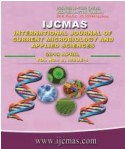


 National Academy of Agricultural Sciences (NAAS)
National Academy of Agricultural Sciences (NAAS)

|
PRINT ISSN : 2319-7692
Online ISSN : 2319-7706 Issues : 12 per year Publisher : Excellent Publishers Email : editorijcmas@gmail.com / submit@ijcmas.com Editor-in-chief: Dr.M.Prakash Index Copernicus ICV 2018: 95.39 NAAS RATING 2020: 5.38 |
Soil organic carbon (SOC) dynamics in croplands is a crucial component of global carbon (C) cycle. Depending on local environmental conditions and management practices, typical C input is generally required to reduce or reverse C loss in agricultural soils. Changes in the soil organic carbon (SOC) stock are determined by the balance between the carbon input from organic materials and the output from the decomposition of soil C. The fate of SOC in cropland soils plays a significant role in both sustainable agricultural production and climate change mitigation. Tillage systems can influence C sequestration by changing aggregate formation and C distribution within the aggregate. Results showed that the soil organic carbon (SOC) stock in bulk soil was 40.2-51.1% higher in the 0.00-0.05 m layer and 11.3-17.0% lower in the 0.05-0.20 m layer in NT system no-tillage without straw (NT-S) and with straw (NT+S), compared to the MP system moldboard plow without straw (MP-S) and with straw (MP+S), respectively. Residue incorporation caused a significant increment of 15.65% in total water stable aggregates in surface soil (0–15 cm) and 7.53% in sub-surface soil (15–30 cm). In surface soil, the maximum (19.2%) and minimum (8.9%) proportion of total aggregated carbon was retained with >2 mm and 0.1–0.05 mm size fractions, respectively. DSR combined with zero tillage in wheat along with residue retention (T6) had the highest capability to hold the organic carbon in surface (11.57 g kg-1 soil with the highest stratification ratio of SOC (1.5). A considerable proportion of the total SOC was found to be captured by the macro-aggregates (>2–0.25 mm) under both surface (67.1%) and sub-surface layers (66.7%) leaving rest amount in micro-aggregates and ‘silt + clay’ sized particles. Soil tillage practices have a profound influence on the greenhouse gas (GHG) balance. However there have been very few integrated studies on the emission of carbon dioxide (CO2), methane (CH4) and nitrous oxide (N2O) and soil biophysical and chemical characteristics under different soil management systems. Tillage played a significant role in the flux of CO2 and CH4. In contrast, N2O flux was determined mainly by microbial biomass carbon and soil moisture content. Compared with other treatments, NT significantly reduced CH4 emission among the rice growing seasons. However, much higher variations in N2O emission were observed across the rice growing seasons due to the vulnerability of N2O to external influences. The amount of CH4 emission in paddy fields was much higher relative to N2O emission. Conversion of CT to NT significantly reduced the cumulative CH4 emission for both rice seasons compared with other treatments. The mixing of residues/surface retention into the soil increases SOM mineralisation due to greater exposure to microbial decomposers and optimal moisture and temperature regimes. Soil disturbance by tillage leads to destruction of the protective soil aggregate. This in turn exposes the labile C occluded in these aggregates to microbial breakdown. The present study found that SOC change was significantly influenced by the crop residue retention rate and the edaphic variable of initial SOC content.
 |
 |
 |
 |
 |